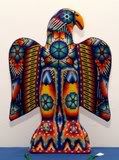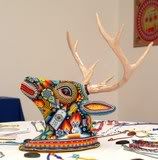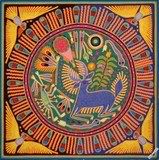This is the Yurata store or “the gallery” as they like to call it.
Here is art from the community, that is also a cooperative.
The popular art that is normally exhibited in large numbers does not name the artist nor
the community that has created it, and this is why it always has
run into the situation of being seen as “handicrafts”.
Indigenous art can be divided into two forms: utilitarian art and ceremonial art.
Utilitarian art is the kind most used in indigenous communities for
necessary purposes, and because of this it is termed “handicraft” because many times
it is art that is done in “series”, but is not made by machines, nor in factories. It is simply
a way that our communities have to live and many times this is why
the art is produced in a series.
Some people perceive indigenous art as repetitive, but in our case important
elements such as deer, peyote and the Mara’kames appear often
due to the composition of the work and the
stories that we tell that are very closely tied to these elements,
symbols of the ancient world of the Gods, of the Sacred World.
The other art is ceremonial art that we use in offerings and ceremonies.
This art varies from the creation of paintings, weavings, and complex work in wood
of a rich and profound spiritual nature, to handmade musical instruments
such as violins and guitars, among others.
These objects and works of ceremonial art normally are kept
in sacred places and are forms of thanking the Spirits and the Sacred Ones,
for having given us the word and good thoughts so that the artist
is able to learn this special way to do art.
In the world that we live in today, art in many cases is treated
as a product that does not have value, but does have a price.
“If it’s framed, it’s art”…
And this has obliged indigenous communities to sell their art under
bad conditions and to fall into the vicious circle of middlemen who
profit from the work of others.
We see that much of the problem for indigenous Mexican art is
the distribution of the art, the way that the art arrives to the buyer.
Middlemen look to make lucrative profits and to this end they lower the
price of art without taking into account the effort, work and labor
that went into the art because all they care about is recuperating their investments.
On the other hand the buyer looks for the best option,
the best offer, and ends up being victim and accomplice to the exploitation and bad
commercialization of art, and in this case the indigenous art
is what we see most affected.
It is a crazy business of buying cheap and selling at high prices.
In this space we want to sell our art, but also to find ways to help
those who buy our art to have the experience of getting to know the artists more directly
and having contact with them.
The purchase of art here not only helps those who
create the art, but also helps to fund our community projects.
Whether for your taste in Huichol art or your desire to help,
we appreciate your interest; for us the sale of our art is a way
for us to be more autonomous and develop our community
based in our way of viewing the world
Developed, yes, but in a way that is intimately tied to our communitarian, cultural and spiritual development.
Music is also a form of art, to listen to the heart as we say,
and this is how we make our Yurata traditional music.
This is only a sample of the art we create, with time
we will expand this page.
If anyone is interested in our art, you can contact us by e-mail
for more payment options and prices























